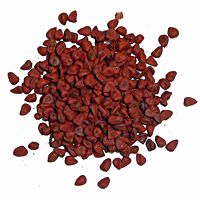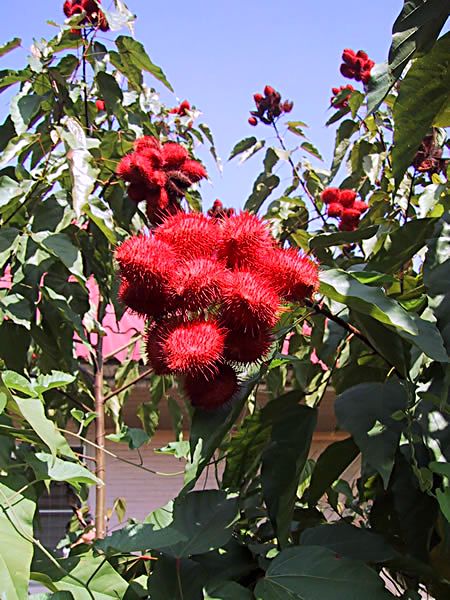 Achuete (Annatto), popularly known as Atsuwete in the Philippines is a derivative of the achiote trees, botanically known as Bixa orellana. Achuete has heart shaped green leaves and rose-pink to white five petaled flowers. The heart-shaped fruits are brown or reddish brown at maturity, and are covered with short, stiff hairs. When fully mature, the fruits split open exposing the numerous dark red seeds. While the fruit itself is not edible, the orange-red pulp that covers the seed is used as a commercial food coloring and dye. There are two compounds that gives atchuete its unique red color: bixin, and norbixin. These compounds are very similar chemically to beta-carotene, the substance which makes carrots red.
Achuete (Annatto), popularly known as Atsuwete in the Philippines is a derivative of the achiote trees, botanically known as Bixa orellana. Achuete has heart shaped green leaves and rose-pink to white five petaled flowers. The heart-shaped fruits are brown or reddish brown at maturity, and are covered with short, stiff hairs. When fully mature, the fruits split open exposing the numerous dark red seeds. While the fruit itself is not edible, the orange-red pulp that covers the seed is used as a commercial food coloring and dye. There are two compounds that gives atchuete its unique red color: bixin, and norbixin. These compounds are very similar chemically to beta-carotene, the substance which makes carrots red.
Achuete is a common cooking ingredient in the Philippines. It’s used as a coloring agent for a variety of popular dishes like Pancit Malabon, Kare-Kare and Chicken Inasal. The seeds are steeped in hot water to extract the characteristic red color, or they are fried in oil to color the oil. The flavor of the seeds is slightly sweet and also peppery, with a touch of nutmeg. Achuete or Annatto is also used to dye textiles.
Production of Achuete (Annatto)
Varieties
There are only two distinct varieties of annatto growing in the country: the White flower with green fruit pods, and the Pink flower with purple pods. Seeds of both varieties are coated with red powder.
Soil and Climate Requirements
Annato grows best in both humid tropics, but can also thrive well in altitudes of up to 1,250 meters provided there is sufficient irrigation. A rich loan soil with adequate moisture is ideal for growing.
Seedbed Propagation
Annato is first propagated in seedbeds. Seeds should from freshly gathered pods and soaked in water before sowing in seedbeds. They may, however, be sown directly in the fields.
The nursery site should be under light shade. Prepare the beds by digging deeply and the seeds at a depth of 2.5 cm. Keep the distance between seeds at 10 cm. in a row and 25 cm. between rows. When the seedling have emerged, thin them or reduced their number to maintain a distance of 10 cm. within rows. In about four months, they are already for transplanting.
Land preparation
Clear the land of the vegetation then plow and harrow twice. Prepare holes as early as 1-1/2 months before planting. Place them 5 to 7 meters apart. They should be about 25 cm deep and 30sq cm wide. Fill in a small amount of manure before putting in the seedlings.
Planting
It is best to transplant seedlings at the beginning of the wet season. Take care not to damage the roots. Keep them from exposure to the sun.
After planting, water them regularly for the next two weeks. Put temporary shades of banana leaves while plants are still young.
Pruning
When plants have grown a meter high, prune or cut the tips if they have not grown primary branches. Secondary branches that are improperly spaced and growing downwards should also be pruned. Prune the shoots, twigs and leaves that hinder the plants from receiving fresh air and sunlight. Do this when the plants have reached three or more years.
Cultivation
Cultivate and weed regularly with the great care so as not to damage the roots. Intercrops such as legumes, leafy vegetables and bulb plants will help eliminate weeds.
Fertilizer Application
For climate with only three months of dry period, apply 15 tons of composed or decomposed organic matter per hectare. Mix this with 200 kg of 2-5-5 (N-P-K) fertilizer each year. Subtract or add to this amount depending on the soil fertility.
Pest and Disease Control
Annato is not seriously attacked by any insect pest. Disease, however, may be acquired such as the powdery mildew disease. This will appear as fine powder on leaf surfaces and eventually caused wilting. Control this by spraying Dithane twice at two-week interval at the rate of 3-1/2 pounds (lbs) per gallon of water.
The twig blight disease results from strong winds and typhoon. Protect the plants with windbreaks before this occur.

Harvest
Full crop of seeds can be harvested after 3 to 4 years after which the plant continually yields more seeds. Gather the fruit capsules or pods when they have become reddish and are about to split open. Cut the bunch with sharp clipper just above the first node below the bunch.
Average yield per tree is 4-1/2 to 5 kg of dried seeds per year. In one hectare, a yield of 350 to 700 kg of seeds per year is possible.
Post Harvest
Spread the pods on a mat or cloth and allow to dry in the sun completely. Turn them over from time to time and protect from rain and night dews. After 10 days when the pods have split open, collect them and place in bags. Afterwards, beat the bag with the stick to release the seeds from the pods. Sift the seeds through a 1/4 size sieve. Remove the fine particles of dirt by “fanning” with hands or sifting further.
Make sure that seeds are bright maroon in color upon picking in the market. Line the packing bags with water proof paper to preserve its freshness.
Source: DOST; Photos: tienchiu.com and naturesflavors.com